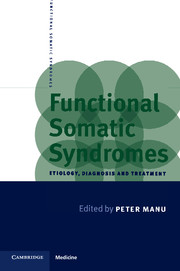Book contents
- Frontmatter
- Contents
- List of contributors
- Preface
- 1 Definition and Etiological Theories
- 2 Chronic Fatigue Syndrome
- 3 Fibromyalgia Syndrome
- 4 Irritable Bowel Syndrome
- 5 Premenstrual Syndrome
- 6 Interstitial Cystitis
- 7 Temporomandibular Disorders
- 8 Chest Pain Syndromes
- 9 Repetitive Strain Injury
- 10 Multiple Chemical Sensitivities
- 11 Psychopharmacology of Functional Somatic Syndromes
- 12 Psychotherapy of Functional Somatic Syndromes
- 13 Determination Of Disability Claimed By Patients With Functional Somatic Syndromes
- 14 Functional Somatic Syndromes: Exploring Common Denominators
- Index
7 - Temporomandibular Disorders
Published online by Cambridge University Press: 08 January 2010
- Frontmatter
- Contents
- List of contributors
- Preface
- 1 Definition and Etiological Theories
- 2 Chronic Fatigue Syndrome
- 3 Fibromyalgia Syndrome
- 4 Irritable Bowel Syndrome
- 5 Premenstrual Syndrome
- 6 Interstitial Cystitis
- 7 Temporomandibular Disorders
- 8 Chest Pain Syndromes
- 9 Repetitive Strain Injury
- 10 Multiple Chemical Sensitivities
- 11 Psychopharmacology of Functional Somatic Syndromes
- 12 Psychotherapy of Functional Somatic Syndromes
- 13 Determination Of Disability Claimed By Patients With Functional Somatic Syndromes
- 14 Functional Somatic Syndromes: Exploring Common Denominators
- Index
Summary
Temporomandibular disorders (TMDs) are a set of clinical conditions characterized by pain in the muscles of the face, head and neck, pain in the temporomandibular joint area, joint sounds, and/or reduced mandibular range of motion. It has been estimated that up to 12% of the population has symptoms consistent with TMDs (Dworkin et al., 1990). Primary care physicians and general dentists are often the first to hear patients complain about this puzzling and persistent pain problem. When primary care physicians are well informed about TMDs, they can educate their patients, as well as provide conservative medical treatments and appropriate referrals.
History
Pain problems associated with the temporomandibular joint (TMJ) and masticatory muscles have been recognized clinically for over 60 years. The first clinical cases were identified by dentists in the 1920s, and the primary responsibility for the diagnosis and treatment of these disorders has remained within the field of dentistry. The evolution of thinking regarding TMDs has included many theories of etiology and pathogenesis, ranging from anatomical features of the TMJ, to occlusal abnormalities, to behavioral origins such as bruxism (grinding the teeth). Many distinct treatments have been applied to TMDs based on presumed pathogenesis or the clinical training of the health care provider. Similarly, several taxonomic systems for classifying orofacial pain problems have been developed over the past two decades (Block, 1980; Eversole & Machado, 1985; Bell, 1986; Fricton et al., 1988; American Academy of Craniomandibular Disorders, 1990).
Keywords
- Type
- Chapter
- Information
- Functional Somatic SyndromesEtiology, Diagnosis and Treatment, pp. 127 - 158Publisher: Cambridge University PressPrint publication year: 1998
- 1
- Cited by

